2023 NISSAN TITAN check engine
[x] Cancel search: check enginePage 541 of 644
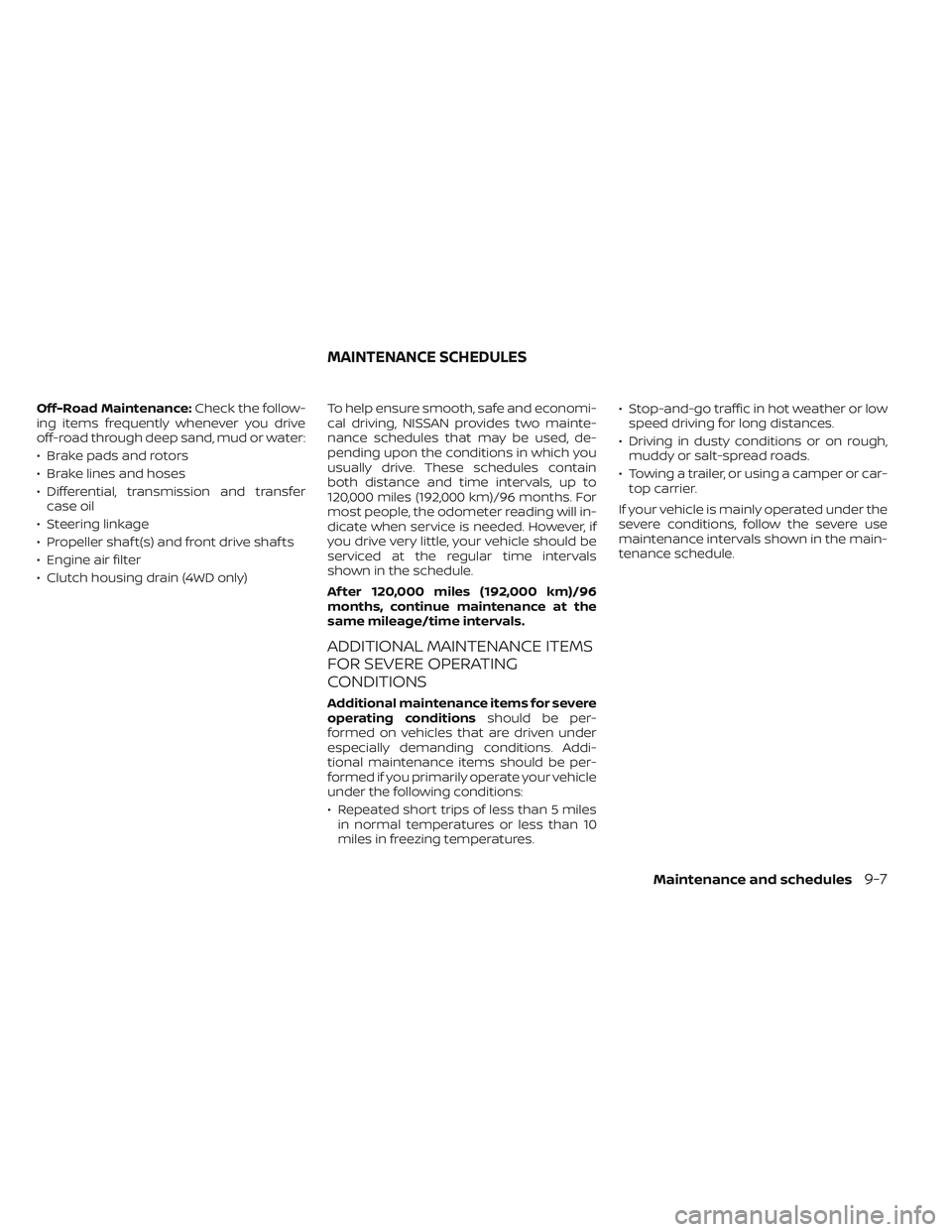
Off-Road Maintenance:Check the follow-
ing items frequently whenever you drive
off-road through deep sand, mud or water:
• Brake pads and rotors
• Brake lines and hoses
• Differential, transmission and transfer case oil
• Steering linkage
• Propeller shaf t(s) and front drive shaf ts
• Engine air filter
• Clutch housing drain (4WD only) To help ensure smooth, safe and economi-
cal driving, NISSAN provides two mainte-
nance schedules that may be used, de-
pending upon the conditions in which you
usually drive. These schedules contain
both distance and time intervals, up to
120,000 miles (192,000 km)/96 months. For
most people, the odometer reading will in-
dicate when service is needed. However, if
you drive very little, your vehicle should be
serviced at the regular time intervals
shown in the schedule.
Af ter 120,000 miles (192,000 km)/96
months, continue maintenance at the
same mileage/time intervals.
ADDITIONAL MAINTENANCE ITEMS
FOR SEVERE OPERATING
CONDITIONS
Additional maintenance items for severe
operating conditions
should be per-
formed on vehicles that are driven under
especially demanding conditions. Addi-
tional maintenance items should be per-
formed if you primarily operate your vehicle
under the following conditions:
• Repeated short trips of less than 5 miles in normal temperatures or less than 10
miles in freezing temperatures. • Stop-and-go traffic in hot weather or low
speed driving for long distances.
• Driving in dusty conditions or on rough, muddy or salt-spread roads.
• Towing a trailer, or using a camper or car- top carrier.
If your vehicle is mainly operated under the
severe conditions, follow the severe use
maintenance intervals shown in the main-
tenance schedule.
MAINTENANCE SCHEDULES
Maintenance and schedules9-7
Page 574 of 644
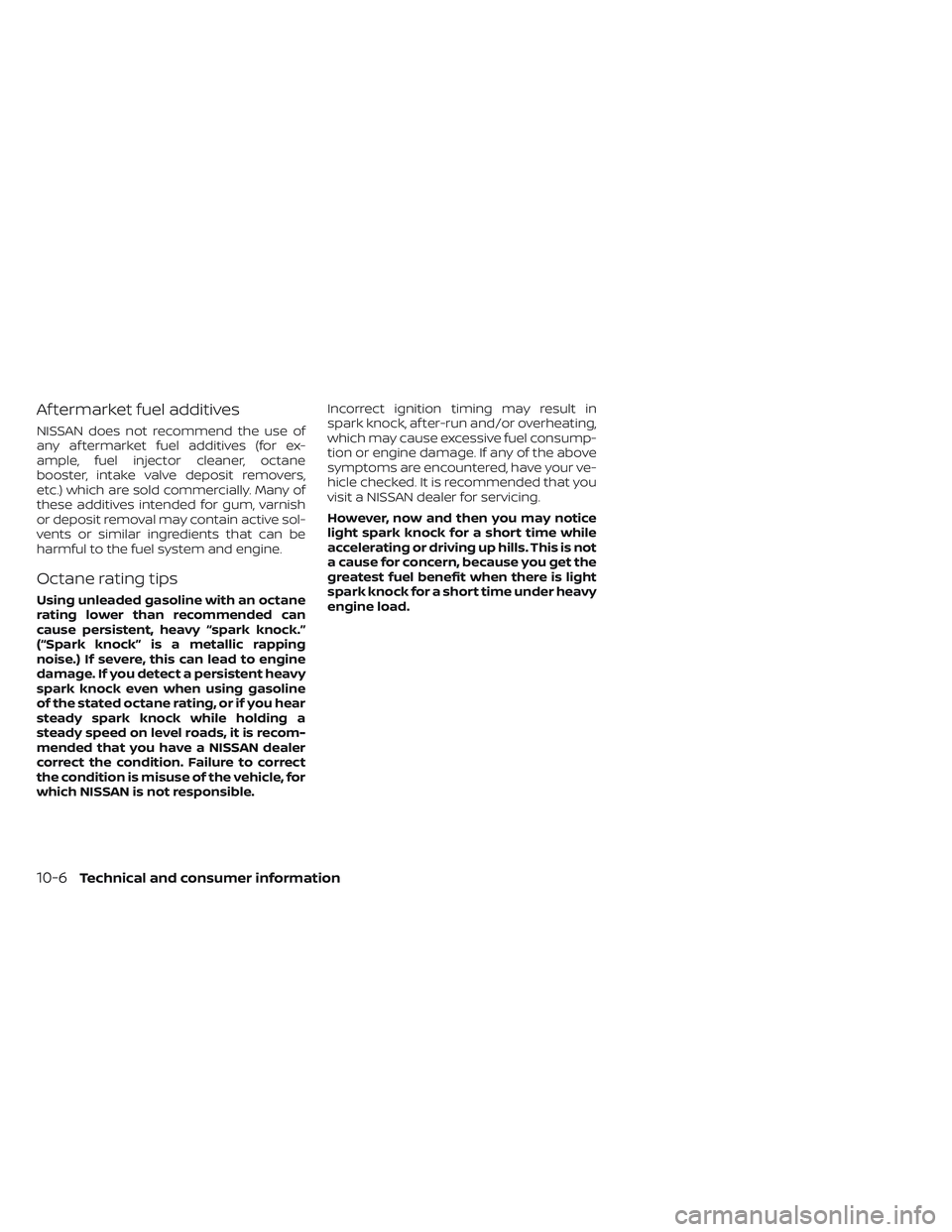
Af termarket fuel additives
NISSAN does not recommend the use of
any af termarket fuel additives (for ex-
ample, fuel injector cleaner, octane
booster, intake valve deposit removers,
etc.) which are sold commercially. Many of
these additives intended for gum, varnish
or deposit removal may contain active sol-
vents or similar ingredients that can be
harmful to the fuel system and engine.
Octane rating tips
Using unleaded gasoline with an octane
rating lower than recommended can
cause persistent, heavy “spark knock.”
(“Spark knock” is a metallic rapping
noise.) If severe, this can lead to engine
damage. If you detect a persistent heavy
spark knock even when using gasoline
of the stated octane rating, or if you hear
steady spark knock while holding a
steady speed on level roads, it is recom-
mended that you have a NISSAN dealer
correct the condition. Failure to correct
the condition is misuse of the vehicle, for
which NISSAN is not responsible.Incorrect ignition timing may result in
spark knock, af ter-run and/or overheating,
which may cause excessive fuel consump-
tion or engine damage. If any of the above
symptoms are encountered, have your ve-
hicle checked. It is recommended that you
visit a NISSAN dealer for servicing.
However, now and then you may notice
light spark knock for a short time while
accelerating or driving up hills. This is not
a cause for concern, because you get the
greatest fuel benefit when there is light
spark knock for a short time under heavy
engine load.
10-6Technical and consumer information
Page 620 of 644
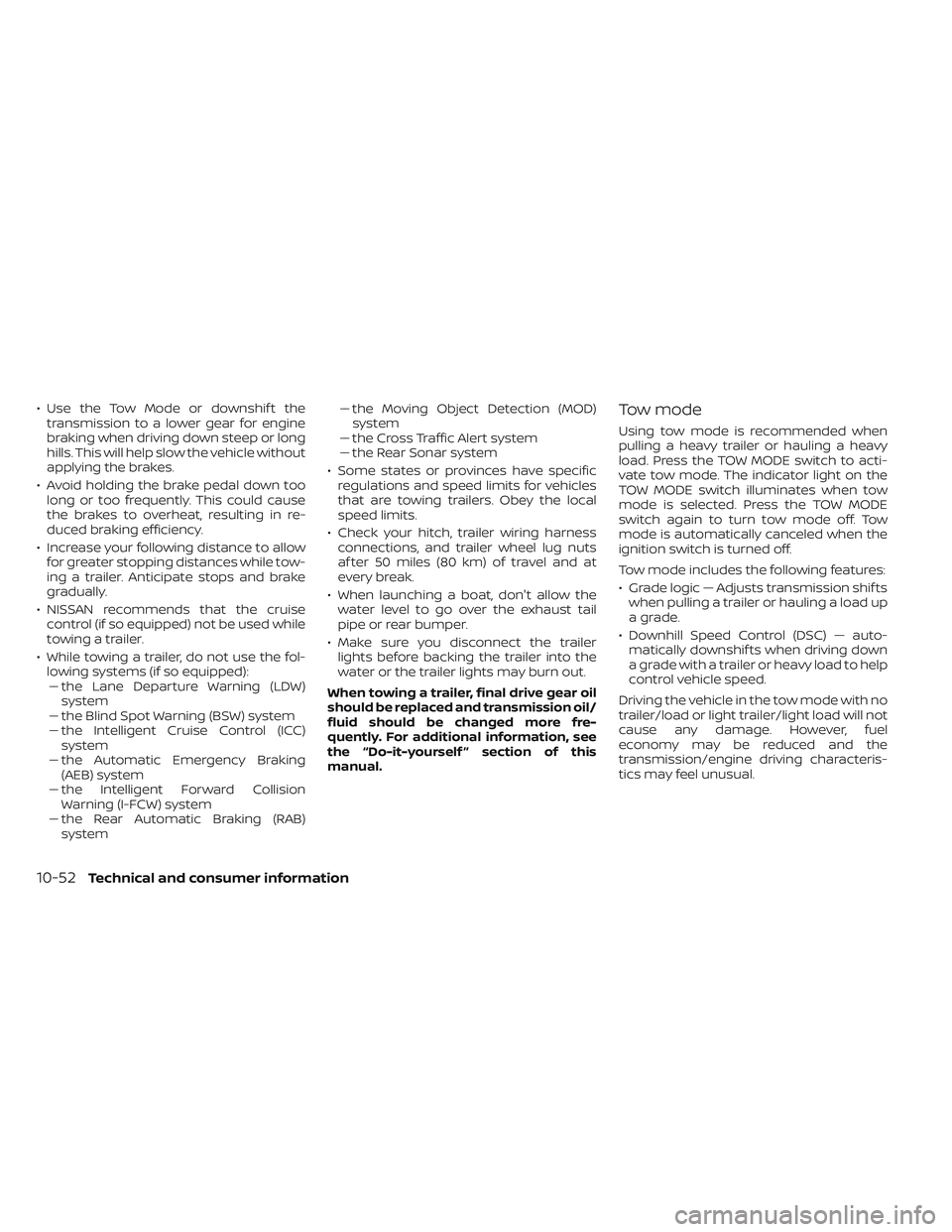
• Use the Tow Mode or downshif t thetransmission to a lower gear for engine
braking when driving down steep or long
hills. This will help slow the vehicle without
applying the brakes.
• Avoid holding the brake pedal down too long or too frequently. This could cause
the brakes to overheat, resulting in re-
duced braking efficiency.
• Increase your following distance to allow for greater stopping distances while tow-
ing a trailer. Anticipate stops and brake
gradually.
• NISSAN recommends that the cruise control (if so equipped) not be used while
towing a trailer.
• While towing a trailer, do not use the fol- lowing systems (if so equipped):–– the Lane Departure Warning (LDW) system
–– the Blind Spot Warning (BSW) system
– – the Intelligent Cruise Control (ICC)
system
– – the Automatic Emergency Braking
(AEB) system
– – the Intelligent Forward Collision
Warning (I-FCW) system
– – the Rear Automatic Braking (RAB)
system –
– the Moving Object Detection (MOD)
system
– – the Cross Traffic Alert system
–– the Rear Sonar system
• Some states or provinces have specific regulations and speed limits for vehicles
that are towing trailers. Obey the local
speed limits.
• Check your hitch, trailer wiring harness connections, and trailer wheel lug nuts
af ter 50 miles (80 km) of travel and at
every break.
• When launching a boat, don't allow the water level to go over the exhaust tail
pipe or rear bumper.
• Make sure you disconnect the trailer lights before backing the trailer into the
water or the trailer lights may burn out.
When towing a trailer, final drive gear oil
should be replaced and transmission oil/
fluid should be changed more fre-
quently. For additional information, see
the “Do-it-yourself ” section of this
manual.Tow mode
Using tow mode is recommended when
pulling a heavy trailer or hauling a heavy
load. Press the TOW MODE switch to acti-
vate tow mode. The indicator light on the
TOW MODE switch illuminates when tow
mode is selected. Press the TOW MODE
switch again to turn tow mode off. Tow
mode is automatically canceled when the
ignition switch is turned off.
Tow mode includes the following features:
• Grade logic — Adjusts transmission shif ts when pulling a trailer or hauling a load up
a grade.
• Downhill Speed Control (DSC) — auto- matically downshif ts when driving down
a grade with a trailer or heavy load to help
control vehicle speed.
Driving the vehicle in the tow mode with no
trailer/load or light trailer/light load will not
cause any damage. However, fuel
economy may be reduced and the
transmission/engine driving characteris-
tics may feel unusual.
10-52Technical and consumer information
Page 625 of 644

WARNING
A vehicle equipped with 4-Wheel Drive
(4WD) should never be tested using a
two wheel dynamometer (such as the
dynamometers used by some states
for emissions testing), or similar equip-
ment. Make sure you inform the test
facility personnel that your vehicle is
equipped with 4WD before it is placed
on a dynamometer. Using the wrong
test equipment may result in transmis-
sion damage or unexpected vehicle
movement which could result in seri-
ous vehicle damage or personal injury.
Due to legal requirements in some states
and Canadian Provinces, your vehicle may
be required to be in what is called the
“ready condition” for an Inspection/
Maintenance (I/M) test of the emission
control system.
The vehicle is set to the “ready condition”
when it is driven through certain driving
patterns. Usually, the ready condition can
be obtained by ordinary usage of the
vehicle. If a powertrain system component is re-
paired or the battery is disconnected, the
vehicle may be reset to a “not ready” condi-
tion. Before taking the I/M test, check the
vehicle's inspection/maintenance test
readiness condition. Place the ignition
switch in the ON position without starting
the engine. If the Malfunction Indicator
Light (MIL) comes on steady for 20 seconds
and then blinks for 10 seconds, the I/M test
condition is “not ready”. If the MIL does not
blink af ter 20 seconds, the I/M test condi-
tion is “ready”. It is recommended that you
visit a NISSAN dealer to set the “ready con-
dition” or to prepare the vehicle for testing.
This vehicle is equipped with an Event Data
Recorder (EDR). The main purpose of an
EDR is to record, in certain crash or near
crash-like situations, such as an air bag
deployment or hitting a road obstacle, data
that will assist in understanding how a ve-
hicle's systems performed. The EDR is de-
signed to record data related to vehicle dy-
namics and safety systems for a short
period of time, typically 30 seconds or less.
The EDR in this vehicle is designed to re-
cord such data as:
• How various systems in your vehicle were
operating;
• Whether or not the driver and passenger safety belts were buckled/fastened;
• How far (if at all) the driver was depress- ing the accelerator and/or brake pedal;
and,
• How fast the vehicle was traveling.
• Sounds are not recorded.
READINESS FOR INSPECTION/
MAINTENANCE (I/M) TEST EVENT DATA RECORDERS (EDR)
Technical and consumer information10-57
Page 627 of 644
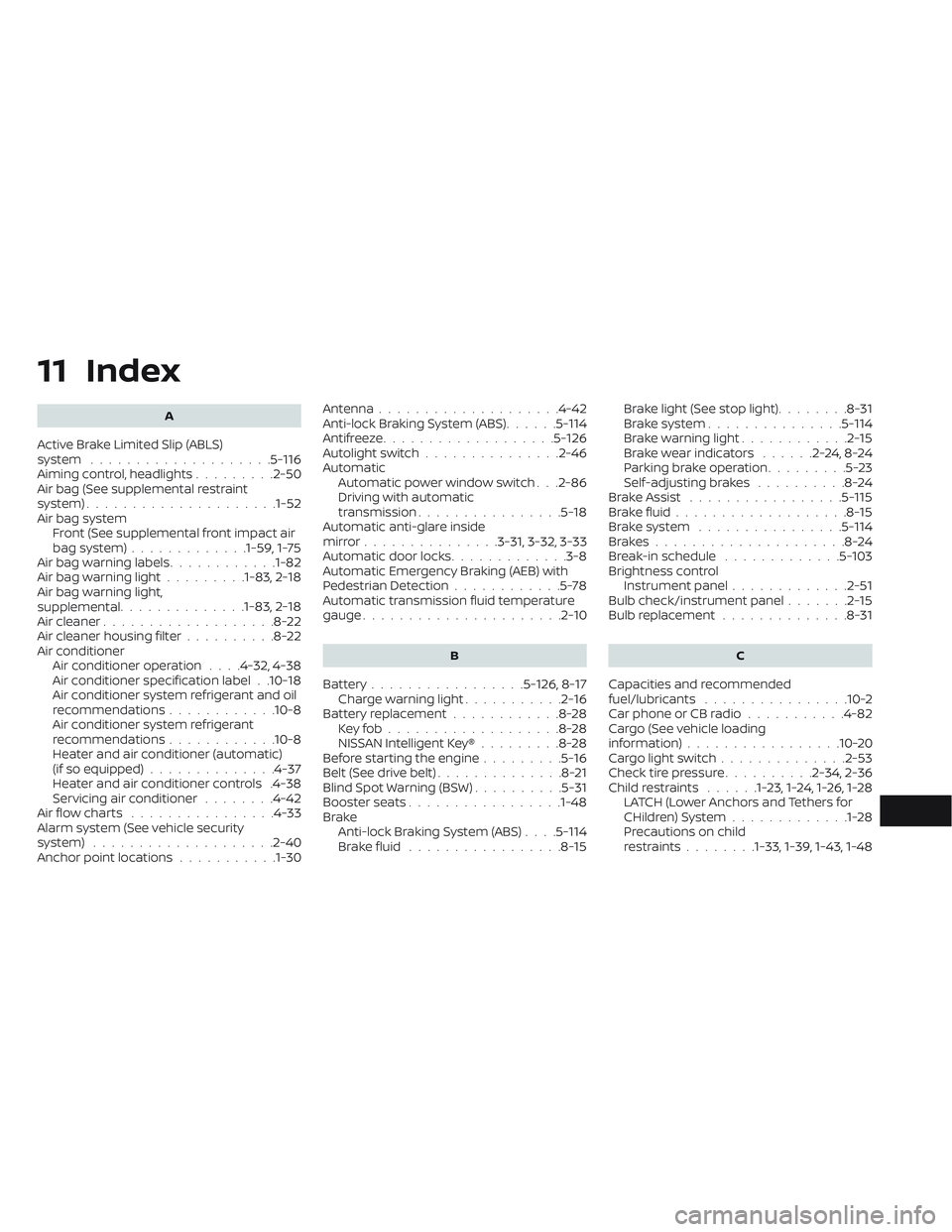
11 Index
A
Active Brake Limited Slip (ABLS)
system....................5-116Aiming control, headlights.........2-50Air bag (See supplemental restraint
system).....................1-52Air bag system
Front (See supplemental front impact air
bag system)
.............1-59, 1-75Air bag warning labels............1-82Air bag warning light.........1-83, 2-18Air bag warning light,
supplemental..............1-83, 2-18Air cleaner...................8-22Air cleaner housing filter..........8-22Air conditionerAir conditioner operation. . . .4-32, 4-38Air conditioner specification label. .10-18Air conditioner system refrigerant and oil
recommendations............10-8Air conditioner system refrigerant
recommendations............10-8Heater and air conditioner (automatic)
(if so equipped)..............4-37Heater and air conditioner controls.4-38Servicing air conditioner........4-42Air flow charts................4-33Alarm system (See vehicle security
system)................... .2-40Anchor point locations...........1-30
Antenna....................4-42Anti-lock Braking System (ABS)......5-114Antifreeze...................5-126Autolight switch...............2-46Automatic
Automatic power window switch. . .2-86Driving with automatic
transmission................5-18Automatic anti-glare inside
mirror...............3-31, 3-32, 3-33Automatic door locks.............3-8Automatic Emergency Braking (AEB) with
Pedestrian Detection............5-78Automatic transmission fluid temperature
gauge......................2-10
B
Battery.................5- 126, 8-17Charge warning light...........2-16Battery replacement............8-28Key fob...................8-28NISSAN Intelligent Key®.........8-28Before starting the engine.........5-16Belt (See drive belt)..............8-21Blind Spot Warning (BSW)..........5-31Booster seats.................1-48Brake
Anti-lock Braking System (ABS). . . .5-114Brake fluid.................8-15
Brake light (See stop light)........8-31Brake system...............5-114Brake warning light............2-15Brake wear indicators......2-24,8-24Parking brake operation.........5-23Self-adjusting brakes..........8-24Brake Assist.................5-115Brake fluid...................8-15Brake system................5-114Brakes.....................8-24Break-in schedule.............5-103Brightness controlInstrument panel.............2-51Bulb check/instrument panel.......2-15Bulb replacement..............8-31
C
Capacities and recommended
fuel/lubricants................10-2Car phone or CB radio...........4-82Cargo (See vehicle loading
information)................ .10-20Cargo light switch..............2-53Check tire pressure..........2-34, 2-36Child restraints......1-23,1-24,1-26,1-28LATCH (Lower Anchors and Tethers for
CHildren) System.............1-28Precautions on child
restraints........1-33, 1-39, 1-43, 1-48
Page 628 of 644
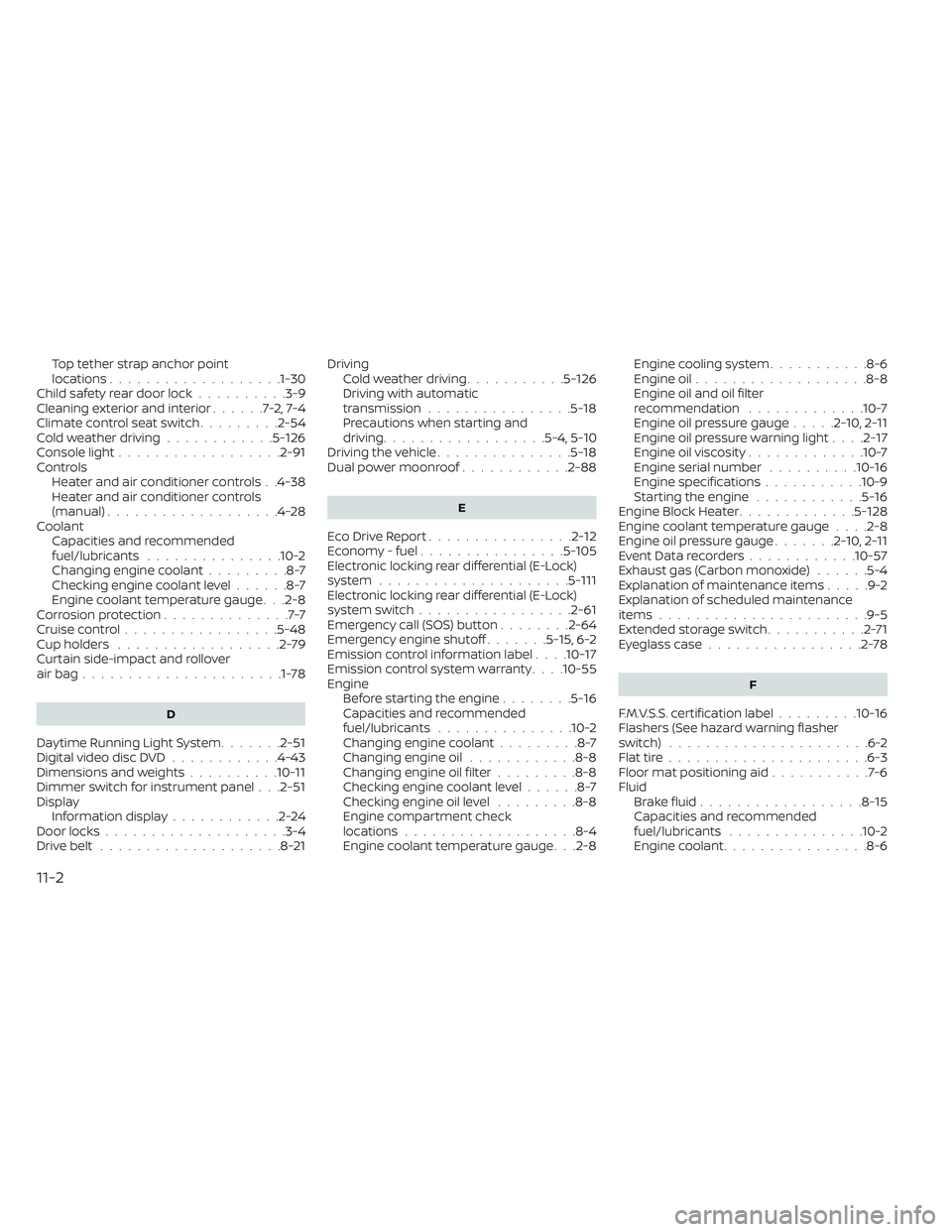
Top tether strap anchor point
locations...................1-30Child safety rear door lock..........3-9Cleaning exterior and interior......7-2,7-4Climate control seat switch.........2-54Cold weather driving............5-126Console light..................2-91Controls
Heater and air conditioner controls. .4-38Heater and air conditioner controls
(manual)...................4-28CoolantCapacities and recommended
fuel/lubricants
...............10-2Changing engine coolant.........8-7Checking engine coolant level......8-7Engine coolant temperature gauge. . .2-8Corrosion protection..............7-7Cruise control................ .5-48Cup holders..................2-79Curtain side-impact and rollover
air bag......................1-78
D
Daytime Running Light System.......2-51Digital video disc DVD............4-43Dimensions and weights..........10-11Dimmer switch for instrument panel. . .2-51Display
Information display............2-24Door locks................... .3-4Drive belt....................8-21
Driving
Cold weather driving...........5-126Driving with automatic
transmission................5-18Precautions when starting and
driving................. .5-4, 5-10Driving the vehicle...............5-18Dual power moonroof............2-88
E
Eco Drive Report................2-12Economy - fuel................5-105Electronic locking rear differential (E-Lock)
system.....................5-111Electronic locking rear differential (E-Lock)
system switch.................2-61Emergency call (SOS) button........2-64Emergency engine shutoff.......5-15,6-2Emission control information label. . . .10-17Emission control system warranty. . . .10-55Engine
Before starting the engine........5-16Capacities and recommended
fuel/lubricants...............10-2Changing engine coolant.........8-7Changing engine oil............8-8Changing engine oil filter.........8-8Checking engine coolant level......8-7Checking engine oil level.........8-8Engine compartment check
locations.................. .8-4Engine coolant temperature gauge. . .2-8
Engine cooling system...........8-6Engine oil...................8-8Engine oil and oil filter
recommendation.............10-7Engine oil pressure gauge.....2-10,2-11Engine oil pressure warning light. . . .2-17Engine oil viscosity.............10-7Engine serial number..........10-16Engine specifications...........10-9Starting the engine............5-16Engine Block Heater.............5-128Engine coolant temperature gauge. . . .2-8Engine oil pressure gauge.......2-10,2-11Event Data recorders............10-57Exhaust gas (Carbon monoxide)......5-4Explanation of maintenance items.....9-2Explanation of scheduled maintenance
items...................... .9-5Extended storage switch...........2-71Eyeglass case.................2-78
F
F.M.V.S.S. certification label.........10-16Flashers (See hazard warning flasher
switch)......................6-2Flat tire......................6-3Floor mat positioning aid...........7-6Fluid
Brake fluid..................8-15Capacities and recommended
fuel/lubricants...............10-2Engine coolant................8-6
11-2
Page 630 of 644
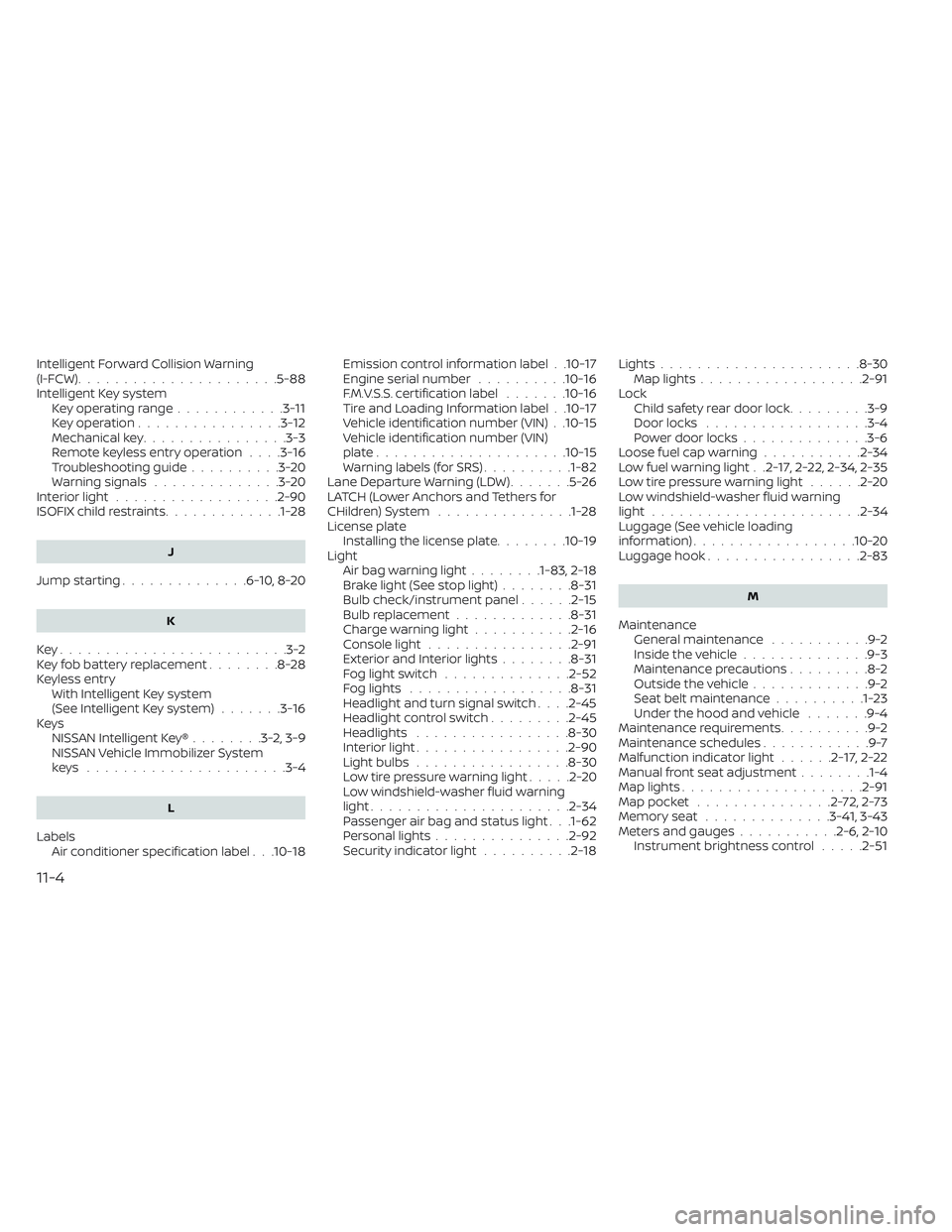
Intelligent Forward Collision Warning
(I-FCW)......................5-88Intelligent Key system
Key operating range............3-11Key operation................3-12Mechanical key................3-3Remote keyless entry operation. . . .3-16Troubleshooting guide..........3-20Warning signals..............3-20Interior light................. .2-90ISOFIX child restraints.............1-28
J
Jump starting..............6-10,8-20
K
Key.........................3-2Key fob battery replacement........8-28Keyless entry
With Intelligent Key system
(See Intelligent Key system)
.......3-16KeysNISSAN Intelligent Key®........3-2,3-9NISSAN Vehicle Immobilizer System
keys..................... .3-4
L
Labels
Air conditioner specification label. . .10-18
Emission control information label. .10-17Engine serial number..........10-16F.M.V.S.S. certification label.......10-16Tire and Loading Information label. .10-17Vehicle identification number (VIN). .10-15Vehicle identification number (VIN)
plate.................... .10-15Warning labels (for SRS)..........1-82Lane Departure Warning (LDW).......5-26LATCH (Lower Anchors and Tethers for
CHildren) System...............1-28License plate
Installing the license plate........10-19LightAir bag warning light........1-83, 2-18Brake light (See stop light)........8-31Bulb check/instrument panel......2-15Bulb replacement.............8-31Charge warning light...........2-16Console light................2-91Exterior and Interior lights........8-31Fog light switch..............2-52Fog lights................. .8-31Headlight and turn signal switch. . . .2-45Headlight control switch.........2-45Headlights.................8-30Interior light.................2-90Light bulbs.................8-30Low tire pressure warning light.....2-20Low windshield-washer fluid warning
light..................... .2-34Passenger air bag and status light. . .1-62Personal lights...............2-92Security indicator light..........2-18
Lights......................8-30Map lights..................2-91Lock
Child safety rear door lock.........3-9Door locks................. .3-4Power door locks..............3-6Loose fuel cap warning...........2-34Low fuel warning light. .2-17, 2-22, 2-34, 2-35Low tire pressure warning light......2-20Low windshield-washer fluid warning
light...................... .2-34Luggage (See vehicle loading
information)..................10-20Luggage hook.................2-83
M
Maintenance
General maintenance...........9-2Inside the vehicle..............9-3Maintenance precautions.........8-2Outside the vehicle.............9-2Seat belt maintenance..........1-23Under the hood and vehicle.......9-4Maintenance requirements..........9-2Maintenance schedules............9-7Malfunction indicator light......2-17,2-22Manual front seat adjustment........1-4Map lights................... .2-91Map pocket...............2-72,2-73Memory seat..............3-41, 3-43Meters and gauges...........2-6, 2-10Instrument brightness control.....2-51
11-4
Page 631 of 644

MirrorAutomatic anti-glare inside
mirror
..............3-31, 3-32, 3-33Heated mirrors...............3-36Outside mirrors..............3-33Rearview.................. .3-31Vanity mirror................3-30Mirrors..................... .3-31Moonroof.................2-88, 7-5Moving Object Detection (MOD)......4-23
N
NISSAN Intelligent Key®..........3-2,3-9NISSAN Vehicle Immobilizer
System................. .2-41, 5-16NissanConnect® Owner's Manual......4-2
O
Octane rating (See fuel octane rating). .10-6Odometer....................2-7Oil
Capacities and recommended
fuel/lubricants
...............10-2Changing engine oil............8-8Changing engine oil filter.........8-8Checking engine oil level.........8-8Engine oil.................. .8-8Engine oil and oil filter
recommendation.............10-7Engine oil viscosity.............10-7Outside mirrors................3-33
Overhead sunglasses holder........2-78Overheat
If your vehicle overheats.........6-12Owner's manual order form........10-58Owner's manual/service manual order
information................. .10-58
P
Parking
Parking brake operation.........5-23Parking/parking on hills.........5-112Parking brake.................5-23Personal lights................ .2-92Power
Front seat adjustment...........1-5Power door locks..............3-6Power outlet.............2-67, 2-68Powerrearwindows...........2-85Power steering fluid............8-14Power steering system.........5-113Power windows..............2-84Rear power windows...........2-85Power inverter switch............2-62Power outlet..............2-67, 2-68Power steering................5-113Power steering fluid..............8-14PrecautionsMaintenance precautions.........8-2On-pavement and off-road driving
precautions................ .5-8Precautions on booster
seats...........1-33, 1-39, 1-43, 1-48
Precautions on child
restraints.........1-33, 1-39, 1-43, 1-48Precautions on seat belt usage.....1-15Precautions on supplemental restraint
system.................1-52, 1-67Precautions when starting and
driving................. .5-4, 5-10Push starting..................6-12
R
Radio
Car phone or CB radio..........4-82Rain sensor.................. .2-44Readiness for inspection maintenance (I/M)
test...................... .10-57Rear Automatic Braking (RAB).......5-73Rear center seat belt.............1-22Rear Cross Traffic Alert (RCTA).......5-41Rear Door Alert.............2-35, 2-66Rear power windows.............2-85Rear seat.....................1-4Rear Seat Infotainment (RSI) System. . .4-43Rear sliding window.............2-87Rear sonar system OFF switch.......2-63Rear window and/or outside mirror
defroster switch................2-45Rearview mirror................3-31RearView Monitor................4-3Recommended Fluids............10-2Recorders
Event Data................ .10-57Refrigerant recommendation.......10-8
11-5